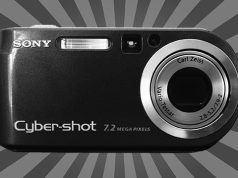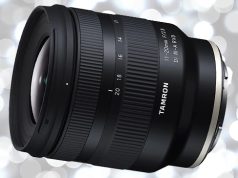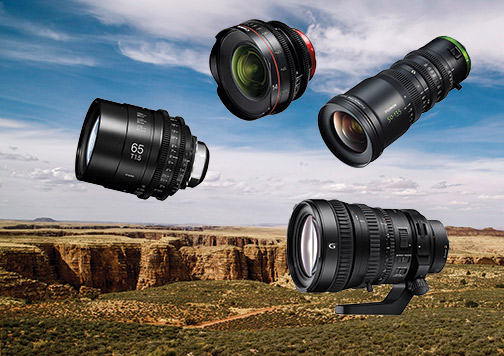
With everyone from vloggers, YouTubers and emerging filmmakers to full-blown pro photographers now serious about shooting video, cinema lenses are no longer confined to the professional cinematography/videography sector. Instead, they make up one of the hottest big-ticket categories in the optical space.
These purpose-built lenses are growing in popularity across content creator categories. And lens makers are responding. Indeed, more than half the lenses covered here, including three with autofocus, are new to our 2023 roundup. Moreover, these lenses represent only a fraction of the cine lenses that have debuted over the last few years.
Purpose-built cine lenses are targeted at content creators laser focused on taking their productions up a notch or three to a truly professional level. True cine lenses provide more precise control of all imaging parameters and enable a more seamless shooting experience. They also deliver greater flexibility, and—here’s the kicker—provide objectively superior video performance.
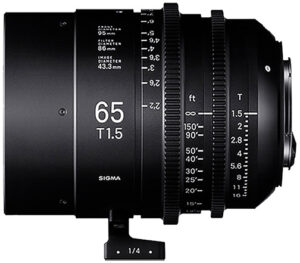
Designing and manufacturing true cine lenses is especially demanding. That’s because it requires an exceptionally high level of mechanical and optical precision. As a result, cine lenses can be quite expensive. In fact, some of the newest lenses covered here range between $3K and $4K, and others fall into the $6K to $14K class. We’ve also included some budget-friendly models.
However, when you consider the time and effort expended on creating a high-end video production, acquiring a lens that can give you an edge is often a wise investment. Fortunately for dealers, no matter what kind of cameras your customers are using to capture video, true purpose-built cine lenses provide a great way to achieve pro-caliber results.
The 411 on Cinema Lenses
Here are six reasons cine lenses are the best option for pro-level video.
1. Cine lenses have smooth operating (de-clicked, stepless) mechanical aperture rings and extremely smooth zoom controls. They also feature ultrasmooth, long-throw manual controls. These usually have standardized external gears that pair with integral or modular servo-control mechanisms for smoother, more predictable field operation. However, some filmmakers prefer manual control rings because there’s no time lag and they provide a more sensitive feel than electronically controlled systems.
2. Cine lenses are almost always parfocal: they maintain focus at the set value as you zoom or change apertures, instead of “breathing,” (shifting focus when you alter other settings). Focus breathing can happen with general-purpose DSLR and mirrorless lenses for still-picture shooting. Many cine lenses also use internal focusing that helps maintain physical balance at all settings and suppresses focus shifts and off-axis changes.
3. Cine lenses typically feature high build quality to withstand heavy use. Most are weatherproof. Plus, clearly marked focusing rings with hard stops at both ends make it easier to achieve focus on moving subjects: you slowly rotate the focus ring while “following” the subject.
4. Cine lenses are usually precision calibrated in T stops to ensure uniform light transmission. Their calibrated scales are reliable. Moreover, the diameters of their front filter rings and overall feel/balance, are typically uniform over a given line. Additionally, they usually don’t have parts that protrude during operation.
5. Cine lenses generally have matching imaging characteristics, such as color balance, contrast and rendition within a brand. Thus, footage shot with different focal lengths looks consistent without postproduction correction.
6. Cine manufacturers keep the most common focal lengths at roughly the same weight with similar controls. This helps assure uniform balance and handling characteristics.
A Medley of Sensational Cinema Lenses
Fujifilm Fujinon MK50–135mm T2.9
This is a full manual cinema lens compatible with Fujifilm’s X series interchangeable-lens cameras. Optimized for shooting videos, it minimizes focus shift and optical axis shift while zooming as well as reduces lens breathing. The high-spec, lightweight tele-zoom covers the 3-perf Super 35 format at a 16:9 aspect ratio. Moreover, it features three separate 0.8 Mod geared control rings for focus, iris and zoom that interface with standard cine lens accessories. Its focusing helical provides 200° of rotation for precise focus pulls.
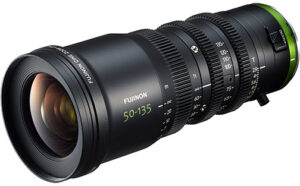
In addition, its click-less 9-blade iris (aperture) enables smooth iris pulls and enhances bokeh. Plus, macro mode enables frame-filling close-ups. The lens is also color matched to other Fujinon lenses in the HK, ZK and XK series. Further, its 85mm front diameter is compatible with a range of matte boxes. And a built-in flange focal adjustment obviates the need for shims. The lens incudes a lens support foot.
It’s built with 22 glass elements in 17 groups, including two super extra-low dispersion (ED) lens elements and two ED lens elements. The Fujinon MK50–135mm T2.9 measures 8.12 inches in length and weighs in at a portable 2.4 pounds. In Canon RF, Micro Four Thirds (MFT) and Sony E mount, $4,299.95.
Meike 85mm T2.1 FF
This impressive fast tele prime cinema lens focuses down to 33.5 inches for frame-filling close-ups. In addition, the Meike lens provides a wide 45mm image circle. It also has standard 0.8 Mod focus and iris gears for motorized coupling.
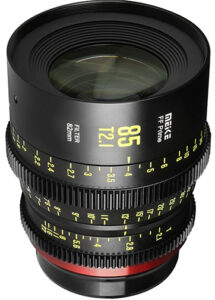
What’s more, an 11-blade diaphragm creates smooth, natural bokeh. What’s more, a 330° focus ring rotation facilitates focusing precision and easy focus pulls. The 14-element, 8-group lens is calibrated in both feet and meters. It stops down to T22 and covers a 23.6° angle of view.
In addition, the cine lens takes 82mm filters. It measures 5.4 inches long and weighs in at 2.4 pounds. The Meike 85mm T2.1 is available in Sony E, Canon EF/RF, Leica L as well as Arri PL mounts. $998.
Samyang Cine V-AF 24mm T1.9 FE
Samyang launched its V-AF lens lineup as “the world’s first lens for video creators designed to make video content creation more convenient.” The Cine V-AF 24mm T1.9 FE is a compact, ultra-light, high-speed, full-frame wide-angle cine lens. The lens is also optimized for use with gimbals and drones.
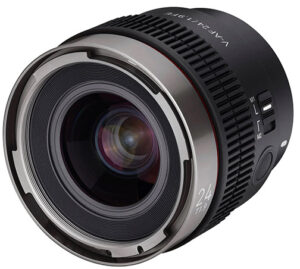
It provides autofocus and includes a sliding switch that lets you save your focus settings when switching between MF and AF. An optional manual focus adapter provides a comprehensive manual focus index. The lens also supports sensors capable of up to 8K recording. Its build features multicoating to minimize flare and ghosting, and it has a 9-blade iris to enhance its smooth natural bokeh.
Moreover, the lens provides a focus rotation of 300° to facilitate smooth focus pulls and precise manual focusing. Furthermore, tally LEDs on the front and rear of the lens confirm that the camera is recording. And since it has the same form factor and center of gravity as others in the Samyang line, you can swap them out without needing to rebalance. The lens measures 2.8 inches and weighs in at only 10 ounces. E mount, $699.
Canon CN-E 14mm T3.1 L F
This outstanding ultrawide Canon cinema lens covers full-frame and Super 35 formats. The prime lens provides 300° of smooth, stepless focusing ring rotation for smooth focus pulls and precise focusing. Its long-throw focusing helical also provides smooth rotation to bring it from infinity to its 31.5-inch minimum focusing distance.

Moreover, it has an 11-blade diaphragm that enhances its pleasing, natural bokeh. Designed to minimize focus breathing, the lens boasts an innovative glass construction to counteract barrel expansion and minimize temperature-related focusing scale discrepancies.
In addition, it has distance markings on both sides of the barrel for enhanced visibility from any shooting angle. Other key features include dust- and water-resistant construction; a 114mm front barrel; 36° iris rotation; and gear positions that match the other Canon CN-E lenses to facilitate easy swaps. The Canon CN-E 14mm T3.1 L F measures 3.7 inches in length and weighs in at 2.7 pounds. Canon EF mount, $3,999.
Irix 30mm T1.5
This Irix cinema lens is for full-frame cine capture on sensors up to full frame and video resolutions up to 8K. The compact, high-speed semi-wide-angle lens provides apertures from T1.5 to T16. It also has luminous focus markings in feet to facilitate low light use and standard 0.8 Mod focus and iris gears.
The internal focusing system of the lens guarantees sharpness. Thanks to the advanced internal focusing optical design, balance is maintained at all settings and distortion is extremely low. Aberrations are also very well corrected, and focus breathing is minimal. In addition, it uses comprehensive multicoating to minimize flare and ghosting.
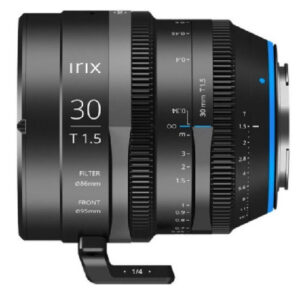
Further, an 11-blade iris provides beautiful rounded bokeh and a very smooth adjustment between T1.5 and T16. An adaptive gear ring function keeps the lens housing sleek and user friendly whether used manually or with accessories. The lens also provides two locations for attaching a 1/4″x 20 support foot. In addition, the lens’s magnetic mounting system (MMS) lets you easily mount accessories from the Iris Edge lineup.
Plus, five seals protect against inclement weather and dust, while its magnesium and aluminum alloy construction combines strength and durability with light weight. The lens focuses down to 1.12 feet. It measures 5×3.8 inches (depending on mount) and weighs on average 2.6 pounds. The Irix 30mm T1.5 comes in various mounts: Canon RF/EF, Fujifilm X, Sony E, Nikon Z, Leica L, Olympus/Panasonic MFT and Arri PL. $1,195.
Rokinon 85mm T1.3 Pro XEEN Meister
Announced last year, this is a high-performance super-speed telephoto prime. The Rokinon XEEN Meister lens covers full-frame sensors and meets the requirements for high-res 8K video capture. In addition, it has standard 0.8 Mod focus and iris gears and a 300° lens rotation for precise focus.

It also features a 13-blade diaphragm that yields smooth, oval bokeh. Rokinon also applies its X-coating to minimize reflections and ghosting. Furthermore, the lens provides a wide 43.2mm image circle and a 28.5° full-frame horizontal angle of view.
What’s more, it sports luminous focus and iris markings to facilitate low-light use. Ideal for creative depth-of-field control, the Rokinon 85mm T1.3 Pro focuses down to 2.6 feet. It extends 6.1 inches from the camera and weighs in at 4.6 pounds in the Sony E-mount and 4.2 pounds in Canon EF and PL (with Cooke /i Technology) mounts. $6,995.
Sigma 65mm T1.5 FF High-Speed Cine
With Cooke i/Technology, this Sigma cine prime features the same high-quality optics and mechanics as the Sigma FF prime line in a cine configuration. The high-speed moderate tele provides full-frame sensor coverage as well as captures a tighter “normal look” perspective. Its lightweight form factor houses an aperture unit from T1.5 to T22. A click-less 9-blade iris enhances its natural bokeh.
In addition, its imaging characteristics and color balance match Sigma Art series lenses. This allows easy lens switching without recalibration. The lens also uses the industry standard 0.8 Mod pitch gears, and all controls are similarly positioned to allow compatibility. What’s more, its focus barrel rotates 180° for smooth focus pulls, and all control rings have dampeners and durably engraved markings.
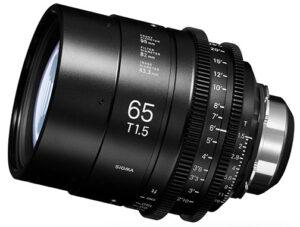
The lens also provides a high degree of correction for chromatic aberrations and distortion, and its build assures excellent peripheral illumination. And with Cooke i/Technology, it transfers lens metadata for VF/X work and other postproduction enhancements.
Additional features include dust- and water-resistant construction and a 2.2-foot close focus distance with a 1:7.9 magnification ratio. It also incorporates a lens support foot with a 1/4″x20 mounting thread. The lens measures 4.8 inches and weighs 2.7 pounds Arri PL mount, $3,899.
Editor’s Note: This lens was just released in the Sony E mount and is also available in the Canon EF mount. Both are somewhat heavier and a bit longer, and neither incorporates the Cooke i/Technology of the PL mount. E and EF mounts, $3,499.
Venus Laowa Ranger 28–75mm T2.9 Cine
Just introduced as a member of the Venus Optics’ Ranger cine series, this is a versatile, full-frame, constant-aperture zoom. It features a 22-element, 18-group parfocal design with a 2.7x zoom ratio and virtually no focus breathing. The lens can also get down to 19 inches for dramatic close-ups.
Also featured is a professional cine housing with built-in back focus adjustment that eliminates the need for shims when focus calibrating. In addition, it has standard 0.8 Mod gearing on the iris and focus controls. Further, an 11-blade diaphragm augments its inherently smooth, natural bokeh.
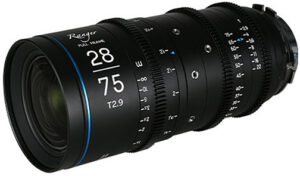
What’s more, it has unified gear positions within the Ranger line, as well as dual metric and footage scales. The lens provides a 270° focus throw and a 100° zoom throw to provide finer, more accurate focus and zoom settings. An 80mm outer diameter and 77mm filter thread accommodate common matte box and filter sizes. Plus, a built-in support foot with a conveniently placed thread facilitates perfect balance when mounted on a tripod.
Beautifully made and finished, the Laowa Ranger 28–75mm T2.9 measures 3.1 inches in width, 7.1 inches in length and weighs 3 pounds. The lens comes with a native PL mount and an included interchangeable EF mount: $2,999. The manufacturer separately sells interchangeable Canon RF, Sony E, Nikon Z and L mounts: $100 each. Zeiss CP.3 15mm T2.9
Derived from the highly acclaimed Zeiss CP.2, this cinema lens incorporates the same classic optical formula that yields the coveted “Zeiss look.” The superb full-frame wide-angle prime also retains the interchangeable mount feature. Additionally, it has a 15-blade iris diaphragm that enriches its beautiful natural bokeh.
Notably, the CP.3 iteration features improved mechanical construction. It also boasts upgraded antireflection coatings for increased contrast and reduced flare for capturing HDR-format content. Zeiss also reshaped its more ergonomic barrel and achieved more even weight distribution to facilitate handheld shooting. It will also work equally well on a gimbal, a drone or a Steadicam.
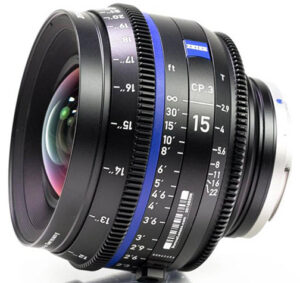
The cine lens covers the full-frame, Super 35 and MFT formats. It also features standard 0.8 Mod 32-pitch gearing on focus and iris controls and a 300° focus rotation for easy focus pulls and enhanced focusing precision. In addition, it focuses down to 12 inches. The lens measures 3.3 inches and weighs in at 1.9 pounds. Nikon F, MFT, Arri PL and Canon EF mounts (all without the XD feature), $6,100.
Editor’s Note: The Zeiss CP.3 XD 15mm T2.9 compact prime version of this lens in the Arri PL mount incorporates Zeiss eXtended Data (XD) technology. It combines Cooke’s i/lens metadata with Zeiss-specific datasets for each lens. The data is transmitted in real time through pins on the PL mount and a 4-pin LEMO port on the lens barrel. This data, captured for each frame, enables more accurate focus pulling. It also permits DITs using Pomfort or DaVinci Resolve software to analyze footage and remove distortion and shading in postproduction. $7,490.
Schneider Xenon 50mm T2.1 FF-Prime Cine-Tilt
This innovative, high-performance Schneider-Kreuznach full-frame normal lens now comes in the E mount. The lens provides a +/- 4° tilt option via a 120° rotation of the tilt control ring. As a result, filmmakers can achieve precise changes in the focus plane. This in turn provides extended creative control of depth of field. Furthermore, when set to 0°, the lens functions like a conventional lens.

Color matched to intercut with other Schneider cine lenses, it covers the full frame with virtually no vignetting. In addition, it’s engineered for 4K capture. Moreover, it features industry standard 0.8 Mod gearing for controlling focus, iris and tilt. Plus, its 300° lens barrel rotation facilitates precise focus point control.
Moreover, the lens utilizes a 14-blade diaphragm to heighten its smooth, natural bokeh. It also provides a 40° angle of view in the full-frame format and 28° in Super 35. It will also focus down to 19.7 inches. The Schneider 50mm T2.1 FF measures 6.4 inches in length and weighs in at 3.1 pounds. Sony E mount, $5,599. A non-tilting edition of this lens is available in Nikon F, Canon EF, Sony E and Arri PL mounts: $3,350.
Sony FE PZ 28-135mm f/4 G OSS
This versatile, full-frame wide-to-tele cine zoom has separate, smooth-action geared control rings for focus, zoom and iris. The Sony lens also incorporates built-in Optical SteadyShot image stabilization (OSS) to minimize the effects of camera shake. In addition, it uses Sony’s advanced iris control and linear AF motor drive system to achieve swift, precise AF with a variety of subjects.

Sony also incorporated Smooth Motion Optics technology to support 4K video capture. The lens features an advanced 18-element, 12-group design. Further it employs five aspheric and three ED lens elements to minimize aberrations and maximize image quality. It is also Nano coated to minimize flare and ghosting.
Also included are manual and variable speed power zoom options. The latter is powered by a quiet, precise SSM (supersonic wave motor), which is the first in a cine lens. Moreover, the lens is parfocal, maintaining precise focus over its entire zoom range without “breathing.”
Sleekly finished in satin black, it also integrates internal focusing to maintain its length and balance. Other features comprise a 9-blade iris for smooth bokeh; apertures of f/4-f/22; and a removable tripod foot. The lens focuses down to 1.3 feet (wide end). It measures 6.5 inches in length and weighs in at a somewhat portable 2.7 pounds. Sony E mount, $2,499.99.
Leitz Cine 35mm T2.0 Summicron-C
Here’s a masterfully crafted, high-performance, semi-wide-angle lens. The high-end Leitz lens provides a 35mm image circle that covers Super 35 as well as APS-C formats. Furthermore, it is compatible with larger sensors, such as the 6K Red Dragon. Thus, it provides a smaller, lighter alternative to the renowned Summilux-C series equivalents.
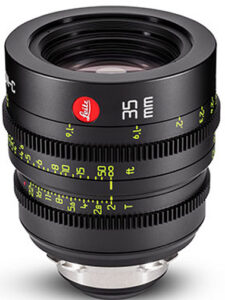
In general, Summicron-C lenses offer authentic color rendition, natural focus transitions and falloff. They also achieve a creamy sharpness that captures everything from portraits to architecture with true representation. What’s more, skin tones remain soft and smooth while hard edges and fine details retain their contrast.
The Leitz Cine 35mm T2.0 additionally features industry-standard geared iris and focus control rings. The latter has a 300° rotation to facilitate smooth focus pulls and precise manual focusing. It also has an internal focus design with a nonrotating front for convenient mounting of matte boxes, etc.
Other features include comprehensive dual focusing scales; low distortion; high resolution; crisp high-def imaging; and smooth naturalistic bokeh. The lens stops down to f/22 and focuses down to just 14 inches. It measures 4 inches and weighs 2.9 pounds. Its dimensions make it a versatile solution for stabilized rigs, aerial cinematography, underwater cinematography as well as stereoscopic 3D imagery. PL mount, $14,600.


